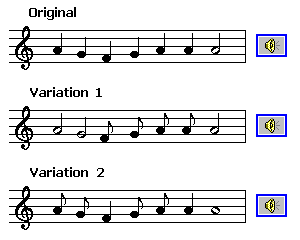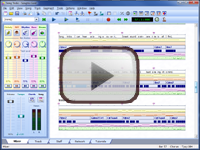(5.2) Note Symbols
Note symbols in staff notation are a series, where each symbol represents half the length of time of the previous one. There are two naming schemes for note symbols.
The American scheme is based on the fractional nature of the symbol series, using names such as whole-note, half-note, quarter-note, and so on. These names are practical, if a little dull.
The British scheme uses traditional names taken from Italian and other languages, such as semibreve, minim, crotchet, and so on. These names are romantic, if a little idiosyncratic.
You can use either scheme, as they both refer to exactly the same note symbols. You should probably learn both. However, the American scheme is more helpful for understanding meter and time signatures, and so this is the scheme we will use in these tutorials.

Let's start with the longest note symbol, the whole-note or semibreve. It appears as a single hollow notehead.
You might reasonably wonder why, if this is a whole-note, it is also called SEMI-breve. In fact, there is a symbol called breve, which is twice as long, but we can safely ignore it. It is of historical interest only and is rarely seen, being incompatible with all commonly used time signatures. More on this later.

Next is the half-note or minim. It is half the length of a whole-note, and appears as a hollow notehead with a stem.
The stem can be oriented either upwards or downwards, and both are shown here. When pointing up, the stem is attached to the right of the notehead, like a letter 'd'. When pointing down, it is attached to the left, like a letter 'p'.
For notes on the lower half of the stave, the stem would usually point up, and for notes on the upper half, it would point down. For notes around the middle of the stave (such as A, B or C with the treble clef), either can be used, whichever works best with the orientation of the surrounding notes.

Then we have the quarter-note or crotchet. It is half the length of a half-note, and appears as a solid notehead with a stem. The stem orientation of the quarter-note (and all the other symbols we will see here) follows the same guidelines as for the half-note.
The quarter-note has a few special claims to fame. Firstly, it is the basis of most common time signatures used in music, such as 3/4 and 4/4. We will look at how these work soon.
Secondly, it is used for measuring tempo, the overall rate of movement of a piece of music. A typical tempo might be expressed as '120 quarter-notes per minute' or 120 qpm. This is often the same as 'beats per minute' (but not always, as we will see).
Finally in computer music (particularly with MIDI, the Musical Instrument Digital Interface) the quarter-note is used to specify the timing precision of musical events in a piece of music, for example '144 ticks per quarter-note', or 144 tpq.

The eighth-note or quaver is half the length of a quarter-note, and appears the same except for the addition of the flag attached to the end of the stem. Notice how the flag always appears to the right of the stem, even when the stem is oriented downwards.
The eighth-note is also used as the basis of several common time signatures, such as 6/8 and 12/8.
The flags of eighth-notes, and also the rest of the symbols shown below, can be replaced with horizontal joining beams to improve readability, in cases where several of these symbols appear next to each other. More on this later.

The sixteenth-note or semiquaver is half the length of an eighth-note, and appears the same except that it has two flags attached to the stem instead of just a single flag. Usually the stem needs to be a drawn a little longer to provide the space for the extra flag.


Similarly, the thirty-second-note and the sixty-fourth-note have their lengths halved each time by the addition of an extra flag to the stem.
Theoretically, this process can continue on for smaller and smaller time lengths, but the symbols become too hard to distinguish, and the sounds become too short to hear (also the British names are becoming something of a mouthful!). In most scores, you will rarely encounter anything shorter than a sixteenth-note.
ChordWizard products such as Songtrix offer a resolution option in Staff View and when printing. You can use this to specify the smallest time divisions that you want individally notated, for example quarter-note, eighth-note, etc.
Using this feature you can control whether to view a piece of music with full notation accuracy or whether you prefer to see a simplified view of it.
Now that we have been introduced to all the note symbols, let's use them by revisiting the melody fragments of the previous topic, based on Mary Had A Little Lamb.

The difference between these variations is now visible as well as audible, so our new notation is doing a much better job of describing the exact melodies.
If you add up the note lengths, you will find the total length of each variation is eight quarter-notes (or two whole-notes). You would rarely see a musical passage this long as a continuous stream. Almost always, music is divided into smaller chunks called bars or measures.

















